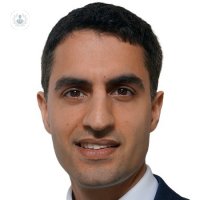Upper lid blepharoplasty: A solution for extra skin in the upper eyelids
Written by:The eyes are often considered the windows to the soul, and their appearance plays a significant role in defining one's facial appearance. However, as time marches on, the delicate skin around the eyes can begin to sag, leading to 'drooping' or a 'hooding' effect' that may not only affect one's appearance but also impact vision. An Upper lid blepharoplasty is a transformative solution performed under local anaesthetic, offering a rejuvenated and refreshed look. In his latest online article, Mr Sameer Trikha explores the intricacies of upper lid blepharoplasty, shedding light on how it can address drooping eyelids and restore a more youthful gaze.

Understanding excess skin (dermatochalasis):
Excess skin over the eyelids, medically known as dermatochalasis, can result from various factors, including aging, genetics, and certain medical conditions. As we age, the skin loses its elasticity, and the skin (along with the muscles supporting the eyelids) may weaken, leading to a hooding effect and/or descent of the upper eyelid. This not only contributes to a tired and aged appearance but can also obstruct the field of vision in severe cases.
Enter upper lid blepharoplasty:
Upper lid blepharoplasty, commonly referred to as an eyelid lift, is a surgical procedure designed to address sagging or drooping upper eyelids. The primary goals of this procedure are to remove excess skin, and tighten underlying muscles if necessary. Sometimes we can also eliminate or reposition fat deposits that contribute to the sagging appearance.
Procedure overview:
- Consultation: Before undergoing upper lid blepharoplasty, I recommend a detailed consultation. During this consultation, I assess the patient's eyelid anatomy, discuss expectations, and develop a personalised treatment plan.
- Anaesthesia: Upper lid blepharoplasty is often performed under local anaesthesia with sedation or general anaesthesia, depending on the surgeon and patients' preference and comfort level.
- Incision placement: When performing this surgery, I strategically place incisions along the natural creases of the upper eyelids, ensuring that scars are well-hidden once healed.
- Tissue adjustment: Excess skin is carefully removed, and the underlying muscles may be tightened to provide support. Additionally, fat may be repositioned or removed to create a more youthful contour.
- Sutures and recovery: The incisions are meticulously closed with sutures, and patients are given post-operative care instructions. Recovery time varies, but most individuals can expect some bruising and swelling initially, which gradually subsides over a few weeks.
Benefits of upper lid blepharoplasty:
1. Restored vision: By eliminating excess skin that may obstruct the field of vision, upper lid blepharoplasty can enhance eyesight and overall visual function.
2. Youthful aesthetics: The removal of sagging skin and the repositioning of fat deposits contribute to a more youthful and rejuvenated appearance.
3. Boost in confidence: Many individuals experience a significant boost in self-confidence after the procedure, as their eyes now reflect a more vibrant and alert expression.
Mr Sameer Trikha is an esteemed ophthalmologist with over 20 years of experience. You can schedule an appointment with Mr Trikha on his Top Doctors profile.


